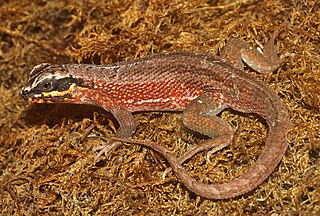
The Tropiduridae are a family of iguanid lizards. The family is sometimes considered a subfamily, Tropidurinae. The subfamily is native to South America, including the islands of Trinidad and the Galápagos. Commonly known as Neotropical ground lizards, most are ground-dwelling animals, and the subfamily includes some lizards adapted to relatively cold climates, including those of the Andes mountains and Tierra del Fuego. Several species give birth to live young.

Microlophus is a genus of tropidurid lizards native to South America. Around 20 species are recognized and 10 of these are endemic to the Galápagos Islands, where they are commonly known as lava lizards. The remaining, which often are called Pacific iguanas, are found in the Andes and along the Pacific coasts of Chile, Peru, and Ecuador.

Iguania is an infraorder of squamate reptiles that includes iguanas, chameleons, agamids, and New World lizards like anoles and phrynosomatids. Using morphological features as a guide to evolutionary relationships, the Iguania are believed to form the sister group to the remainder of the Squamata, which comprise nearly 11,000 named species, roughly 2000 of which are iguanians. However, molecular information has placed Iguania well within the Squamata as sister taxa to the Anguimorpha and closely related to snakes. The order has been under debate and revisions after being classified by Charles Lewis Camp in 1923 due to difficulties finding adequate synapomorphic morphological characteristics. Most Iguanias are arboreal but there are several terrestrial groups. They usually have primitive fleshy, non-prehensile tongues, although the tongue is highly modified in chameleons. The group has a fossil record that extends back to the Early Jurassic. Today they are scattered occurring in Madagascar, the Fiji and Friendly Islands and Western Hemisphere.

Microlophus albemarlensis, the Galápagos Lava lizard, also known as the Albemarle Lava lizard, is a species of Lava lizard. It is endemic to the Galápagos Islands, where it occurs on several islands in the western archipelago: the large islands Isabela, Santa Cruz, Fernandina, Santiago and Santa Fe, as well as several smaller islands: Seymour, Baltra, Plaza Sur, Daphne Major and Rábida. It is the most widespread of the Galápagos species of Microlophus, the others only occurring on single islands. Some authors however, consider populations on Santiago, Santa Cruz, and Santa Fe to be distinct species. The species is commonly attributed to the genus Microlophus but has been historically placed in the genus Tropidurus.

Microlophus pacificus, the common Pacific iguana, is a species of lava lizard endemic to the Galapagos island of Pinta. The species is commonly attributed to the genus Microlophus but has been attributed to the genus Tropidurus.

Microlophus koepckeorum, commonly known as Frost's iguana, is a species of lava lizard in the family Tropiduridae. The species is endemic to Peru.

Tropidurus torquatus is a species of lizard in the family Tropiduridae, the Neotropical ground lizards. Its common name is Amazon lava lizard.
Tropidurus melanopleurus, the black lava lizard, is a species of lizard from the Andean region of western South America, ranging between the three different countries of Peru, Bolivia, and Argentina. It was described in 1902 by zoologist George Boulenger. It is fairly small in size, but is known for its different appearance and differing size between the males and females. However, while the patterns of color may be different between the sexes, both males and females have a very distinct physical color array with a patterned mix of green, orange, cream, black and or brown. This species of lizard lives in a generally warm to hot climate all year round and spends most of its day on the side of vertical rock structures in the mountains, feeding on various types of insects, with an emphasis on ants.

Eurolophosaurus nanuzae, Rodrigues's lava lizard, is a species of South American lava lizard in the family Tropiduridae. The species is endemic to Brazil.
Tropidurus etheridgei, also known commonly as Etheridge's lava lizard, is a species of lizard of the family Tropiduridae. The species is endemic to South America.
Tropidurus helenae is a species of lizard of the Tropiduridae family. It is found in Brazil.
Tropidurus insulanus is a species of lizard of the Tropiduridae family. It is endemic to Brazil and is known from pockets of savanna within the Amazon rainforest of Pará and Mato Grosso states.
Tropidurus itambere is a species of lizard of the Tropiduridae family. It is found in Brazil.
Tropidurus jaguaribanus is a species of lizard of the Tropiduridae family. It is found in Brazil.

Tropidurus montanus is a species of lizard of the Tropiduridae family. It is found in Brazil.

Tropidurus oreadicus is a species of lizard of the Tropiduridae family. It is endemic to Brazil and widely distributed in the Cerrado.
Tropidurus pinima is a species of lizard of the Tropiduridae family. It is found in Brazil.

Tropidurus semitaeniatus, the striped lava lizard, is a species of lizard of the Tropiduridae family. It is found in Brazil.
Tropidurus spinulosus, the spiny lava lizard, is a species of lizard of the Tropiduridae family. It is found in Brazil, Bolivia, Paraguay, and Argentina.












